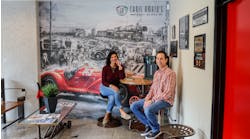The Rolling Meadows, Ill., location of Sterling Autobody Centers spent 2010 working the kinks out of a lean pilot program. Sterling intends to begin rolling out the program in its other 62 shops at the beginning of next year. When fully implemented, the program will transform the working lives of more than 1,200 Sterling employees throughout the country with the potential of impacting many other workers whose shops are influenced by the change.
Many shops claim to have their own, one-of-a-kind lean system. Sterling’s stands out for the scope of its eventual impact and investment in constant, sometimes daily, changes. Twice daily shop general manager Kyle Thomson straps on a reflective orange vests and works his way through every area of the shops on a structured tour known as a Gemba walk. The vest is a visual cue to employees that Thomson is temporarily unable to answer business questions.
“We found managers often spend 80 percent of their time fighting fires and 20 percent actually managing,” says Daniel Briones, director of marketing. “As part of our movement to lean, we wanted to reverse that.”
“When I’m on my walk, it’s my time to focus,” Thomson says. “This is my view from 30,000 feet. It’s when I can get an overall scope of the business and see where we can make changes to improve the workflow.”The Gemba walks, which are highly structured, begin at the shop’s office. Thomson then moves to a special damage analysis area, where all shop work begins. He continues throughout the shop and makes stops at each pulse point – areas where specific work is performed. Each pulse point features a visual marker – a sign, tracking board, etc. – that helps Thomson determine if the work is on schedule. If not, he talks with the department heads to work out a solution, which, for example, can be moving resources.
At some point, Thomson also performs what he refers to as deep dives. He stops in specific departments to analyze work flow even more deeply and then discusses ways to maintain or improve quality while keeping work moving through.Continuous flow is at the center of Sterling’s lean process.
“In a shop, you only have so much capacity for work,” Briones says. “Our goal is to remove bottlenecks, to keep work flowing through to get as much as we can from that capacity.”
Ultimately, Sterling plans to use its system to reduce average cycle time to six days.
Along with the Gemba walks, Sterling’s system makes use of its version of the damage analysis inspection common to many other lean programs. In Sterling’s version, two damage analysis managers and two technicians with the experience are needed to tear down and accurately identify all damage, perform the inspection and help coordinate repairs. Damage analysis managers identify each vehicle according to hit type – light, medium and heavy. Their input helps provide the constant flow the system demands.
“What we’re looking for is the best mix of vehicles that can be handled,” Briones says. “You obviously don’t want to throw in a bunch of heavy hits at the same time because they can tie up different points of the shop. Kyle looks at what work is available and works with the managers to schedule the work in the best manner possible.”
Some light hits can be processed through the shop’s special express repair lane, which is being blended into the shop’s lean process. Vehicles sent to the express lane can be repaired in one or two days. To ensure the two-day criteria, the shop works with its technicians to review any potential problems. A green cone is placed on top of the vehicles to notify estimators and other employees that repairs must be conducted urgently.
“It’s working to our advantage,” Briones says. “It’s helping our cycle time.”
These and other lessons picked up from the six-month pilot program will be passed onto additional Sterling locations beginning this February. Three or four stores will handle the initial deployment. By May 2011, Sterling hopes to have a full-scale deployment to all of its shops.
From there, Sterling normally would be on a three- to five-year journey to transition to lean completely. Using the Rolling Meadows pilot, Sterling expects to achieve 80 percent of its five-year goal in the first year of deployment. During that first year, Sterling’s lean processes will handle much of the 80,000 repairs that roll through the company’s doors annually. Leading the way in this production juggernaut is a single Illinois shop – certainly a Top Shop.

